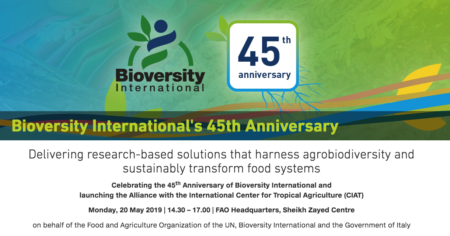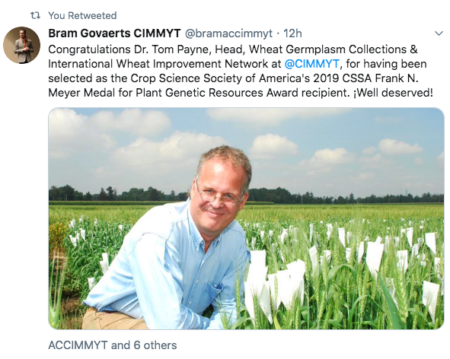I know we’re a day late, but let’s celebrate the International Day for Biological Diversity with antique yeast in a Belgian monastery.
Happy birthday, Bioversity!

Check out the nice anniversary booklet, and listen to the live stream of the celebrations. It’s in just a couple of hours’ time.
Next for Bioversity, of course, is alliance with CIAT, under the guidance of CEO-designate Juan Lucas Restrepo. Best wishes for this important endeavour.
This group of leaders from @BioversityInt and @CIAT_ are putting their energy, bright minds and souls to steer the construction of the Alliance’s Strategic Framework. A huge participatory effort to ensure we thrive and act where society needs us the most. THANKS!! https://t.co/0mFLolctjB
— Juan Lucas Restrepo (@jlucasrestrepo) May 18, 2019
Brainfood: Rice longevity, HTFP, Carob diversity, Coffee diversity, Tea in China, In situ CWR, Hot potatoes, Luffa diversity, Sorghum production constraints, Flax diversity, Fox snout drugs, Hybrids and adaptation
- A high proportion of beta-tocopherol in vitamin E is associated with poor seed longevity in rice produced under temperate conditions. The ratio of different antioxidants is an indicator of seed longevity.
- Review: High-throughput phenotyping to enhance the use of crop genetic resources. Phenomics is the new genomics.
- Genetic structure analysis and selection of a core collection for carob tree germplasm conservation and management. NE Spain is different to the rest.
- Population structure and genetic relationships between Ethiopian and Brazilian Coffea arabica genotypes revealed by SSR markers. Western Ethiopian diversity is largely untapped.
- Clustering analysis for wild ancient tea germplasm resources in Debao County and Longlin County, Guangxi based on SSR molecular markers. They’re quite different to tea from others parts of China.
- Modeling of crop wild relative species identifies areas globally for in situ conservation. 150 sites needed for 65% of 1200 CWR species in 167 genepools.
- Heat Tolerance in Diploid Wild Potato Species In Vitro. S. kurtzianum and S. sogarandinum were the most heat tolerant.
- The establishment of the species-delimits and varietal-identities of the cultivated germplasm of Luffa acutangula and Luffa aegyptiaca in Sri Lanka using morphometric, organoleptic and phylogenetic approaches. The less grown species tasted better.
- A Regional Comparison of Factors Affecting Global Sorghum Production: The Case of North America, Asia and Africa’s Sahel. New varieties needed, and seed exchange.
- The genetic structure of flax illustrates environmental and anthropogenic selections that gave rise to its eco-geographical adaptation. 4 major groups: Temperate, South Asian, Abyssinian and Mediterranean.
- Chemical evidence for the use of multiple psychotropic plants in a 1,000-year-old ritual bundle from South America. Well that’s like your opinion, man.
- Hybridization speeds adaptive evolution in an eight-year field experiment. n=2, but still.
It’s Meyer time!
There’s nothing on the website yet, but it looks like Dr Tom Payne, genebank manager at CIMMYT, has been awarded the Frank N. Meyer Medal for Plant Genetic Resources for 2019. This is richly deserved. Congratulations to Tom, who joins a very illustrious club.

Tom will no doubt celebrate in the newly refurbished lobby of the genebank.
This morning at @CIMMYT's HQ, we inaugurated the new lobby of the Wellhausen-Anderson Plant Genetic Resources Center.
The multi-disciplinary team that led this revamp has truly honored the maize and wheat diversity safeguarded in the genebank. pic.twitter.com/bWN33zrRRR— MartinKropff (@KropffMartin) April 26, 2019
Brainfood: More than yield, Cotton breeding, Chickpea genome, Mutations & domestication, Holy Grail, Restoration, Watermelon diversity, Language diversity, Ocimum diversity, Clean cassava, Neolithic feasting, Amazonian agriculture, Sharecropping
- The paradox of productivity: agricultural productivity promotes food system inefficiency. It’s the cheap calories, stupid.
- Genetic Evaluation of Exotic Chromatins from Two Obsolete Interspecific Introgression Lines of Upland Cotton for Fiber Quality Improvement. Yield from one species, fibre quality from the other.
- Resequencing of 429 chickpea accessions from 45 countries provides insights into genome diversity, domestication and agronomic traits. Including drought tolerance.
- Genome of ‘Charleston Gray’, the principal American watermelon cultivar, and genetic characterization of 1,365 accessions in the U.S. National Plant Germplasm System watermelon collection. Four genetic groups reflecting geography.
- Genome-wide nucleotide patterns and potential mechanisms of genome divergence following domestication in maize and soybean. The best candidates for domestication are plants that are willing to mutate a bit, but not too much.
- Crop Biodiversity: An Unfinished Magnum Opus of Nature. “Linking genotype and phenotype remains the holy grail of crop biodiversity studies.”
- Meeting global land restoration and protection targets: What would the world look like in 2050? Very nice. It would look very nice.
- The ecological drivers of variation in global language diversity. High year-round productivity leads to lots of languages. And lots of biodiversity, but that’s another story.
- Product authenticity versus globalisation—The Tulsi case. The division of Indian Holy Basil into 3 types based on traditional knowledge is only partially supported by genetic and phytochemical studies.
- A method for generating virus-free cassava plants to combat viral disease epidemics in Africa. Let the distribution commence.
- Cereal processing at Early Neolithic Göbekli Tepe, southeastern Turkey. They must have been some feasts.
- Persistent Early to Middle Holocene tropical foraging in southwestern Amazonia. On the cusp of agriculture 10,000 years ago in Bolivia. That’s about the same time as Göbekli Tepe, give or take a thousand years.
- Moral Hazard: Experimental Evidence from Tenancy Contracts. Tenant farmers should keep a higher share to increase productivity and diversity, but of course the landlords won’t let them so what’s needed is revolution.